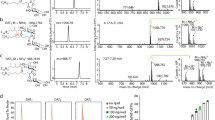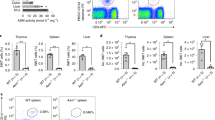Abstract
Glycosphingolipids (GSLs) from the Sphingomonadaceae family of bacteria have been reported to be potent stimulators of natural killer T cells. These glycolipids include mono-, tri- and tetraglycosylceramides. Here we have prepared the GSL-1 to GSL-4 series of glycolipids and tested their abilities to stimulate natural killer T cells. Among these glycolipids, only GSL-1 (1) is a potent stimulator. Using a series of synthetic diglycosylceramides, we show that oligoglycosylceramides from Sphingomonadaceae are not effectively truncated to GSL-1 in lysosomes in antigen-presenting cells, possibly because the higher-order GSLs are poor substrates for lysosomal acyltransfer enzymes.
This is a preview of subscription content, access via your institution
Access options
Subscribe to this journal
Receive 12 print issues and online access
$259.00 per year
only $21.58 per issue
Buy this article
- Purchase on Springer Link
- Instant access to full article PDF
Prices may be subject to local taxes which are calculated during checkout



Similar content being viewed by others
References
Miller, S.I., Ernst, R.K. & Bader, M.W. LPS, TLR4 and infectious disease diversity. Nat. Rev. Microbiol. 3, 36–46 (2005).
Kawahara, K., Kuraishi, H. & Zähringer, U. Chemical structure and function of glycosphingolipids of Sphingomonas spp. and their distribution among members of the α-4 subclass of Proteobacteria. J. Ind. Microbiol. Biotechnol. 23, 408–413 (1999).
Amano, K. et al. Deficiency of peptidoglycan and lipopolysaccharide components in Rickettsia tsutsugamushi. Infect. Immun. 55, 2290–2292 (1987).
Lin, M. & Rikihisa, Y. Ehrlichia chaffeensis and Anaplasma phagocytophilum lack genes for lipid A biosynthesis and incorporate cholesterol for their survival. Infect. Immun. 71, 5324–5331 (2003).
Naka, T. et al. A novel sphingoglycolipid containing galacturonic acid and 2-hydroxy fatty acid in cellular lipids of Sphingomonas yanoikuyae. J. Bacteriol. 182, 2660–2663 (2000).
Selmi, C. et al. Patients with primary biliary cirrhosis react against a ubiquitous xenobiotic-metabolizing bacterium. Hepatology 38, 1250–1257 (2003).
Mattner, J. et al. Both exogenous and endogenous glycolipid antigens activate NKT cells during microbial infections. Nature 434, 525–528 (2005).
Kinjo, Y. et al. Recognition of bacterial glycosphingolipids by natural killer T cells. Nature 434, 520–525 (2005).
Sriram, V., Du, W., Gervay-Hague, J. & Brutkiewicz, R.R. Cell wall glycosphingolipids from Sphingomonas paucimobilis are CD1d-specific ligands for NKT cells. Eur. J. Immunol. 35, 1692–1701 (2005).
Bendelac, A., Savage, P.B. & Teyton, L. Biology of NKT cells. Annu. Rev. Immunol. 25, 297–336 (2007).
Yu, K.O.A. & Porcelli, S.A. The diverse functions of CD1d-restricted NKT cells and their potential for immunotherapy. Immunol. Lett. 100, 42–55 (2005).
Van Kaer, L. α-Galactosylceramide therapy for autoimmune diseases: prospects and obstacles. Nat. Rev. Immunol. 5, 31–42 (2005).
Morita, M. et al. Structure-activity relationship of α-galactosylceramides against B16-bearing mice. J. Med. Chem. 38, 2176–2187 (1995).
Fischer, K. et al. Mycobacterial phosphatidylinositol mannoside is a natural antigen for CD1d-restricted T cells. Proc. Natl. Acad. Sci. USA 101, 10685–10690 (2004).
Zhou, D. et al. Lysosomal glycosphingolipid recognition by NKT cells. Science 303, 523–527 (2004).
Kinjo, Y. et al. Natural killer T cells recognize diacylglycerol antigens from pathogenic bacteria. Nat. Immunol. 7, 978–986 (2006).
Savage, P.B., Bendelac, A. & Teyton, L. Glycolipids for natural killer T cells. Chem. Soc. Rev. 35, 771–779 (2006).
Prigozy, T.I. et al. Glycolipid antigen processing for presentation by CD1d molecules. Science 291, 664–667 (2001).
Zhou, X.T. et al. Synthesis and NKT cell stimulating properties of fluorophore- and biotin-appended 6′′-amino-6′′-deoxy-galactosylceramides. Org. Lett. 4, 1267–1270 (2002).
Andersson, F., Fuegedi, P., Garegg, P. & Nashed, M. Synthesis of 1,2-cis-linked glycosides using dimethy(methylthio)sulfonium triflate as promoter and thioglycosides as glycosyl donors. Tetrahedr. Lett. 27, 3919–3922 (1986).
Garcia, B.A., Poole, J.L. & Gin, D.Y. Direct glycosylations with 1-hydroxy glycosyl donors using trifluoromethanesulfonic anhydride and diphenyl sulfoxide. J. Am. Chem. Soc. 119, 7597–7598 (1997).
Schmidt, R.R. & Michael, J. Einfache synthese von α- und β-O-glycosylimidaten. Herstellung von glykosiden und disacchariden. Angew. Chem. Int. Edn. Engl. 19, 731–732 (1980).
Lee, P.T., Benlagha, K., Teyton, L. & Bendelac, A. Distinct functional lineages of human Vα-24 natural killer T cells. J. Exp. Med. 195, 637–641 (2002).
Liu, Y. et al. A modified α-galactosyl ceramide for staining and stimulating natural killer T cells. J. Immunol. Methods 312, 34–39 (2006).
Roces, D.P. et al. Efficacy of enzyme replacement therapy in α-mannosidosis mice: a preclinical animal study. Hum. Mol. Genet. 13, 1979–1988 (2004).
Lusis, A.J. & Paigen, K. Properties of mouse α-galactosidase. Biochim. Biophys. Acta 437, 487–497 (1976).
Meikle, P.J., Whittle, A.M. & Hopwood, J.J. Human acetyl-coenzyme A: α-glucosaminide N-acetyltransferase: kinetic characterization and mechanistic interpretation. Biochem. J. 308, 327–333 (1995).
Zhou, D. et al. Editing of Cd1-bound lipid antigens by endosomal lipid transfer proteins. Science 303, 523–527 (2004).
Sagiv, Y. et al. Cutting edge: impaired glycosphingolipids trafficking and NKT cell development in mice lacking Niemann-Pick type C1 protein. J. Immunol. 177, 26–30 (2006).
Zhao, H.G., Li, H.H., Bach, G., Schmidtchen, A. & Neufeld, E.F. The molecular basis of Sanfilippo syndrome type B. Proc. Natl. Acad. Sci. USA 93, 6101–6105 (1996).
Acknowledgements
We acknowledge financial support from the National Institutes of Health (NIAID AI053725). J.M. is a Cancer Research Institute fellow and was supported by a grant from the Lupus Research Institute. A.B. is a Howard Hughes Medical Institute Investigator.
Author information
Authors and Affiliations
Contributions
X.L., S.D., Z.Z. and R.D.G. synthesized glycolipids; J.M. and D.Z determined NKT cell stimulatory activity of glycolipids; N.M. isolated glycolipids; L.T., A.B. and P.B.S. designed the project.
Corresponding author
Ethics declarations
Competing interests
The authors declare no competing financial interests.
Supplementary information
Supplementary Text and Figures
Supplementary Figs. 1–5, Supplementary Scheme 1 and Supplementary Methods (PDF 4072 kb)
Rights and permissions
About this article
Cite this article
Long, X., Deng, S., Mattner, J. et al. Synthesis and evaluation of stimulatory properties of Sphingomonadaceae glycolipids. Nat Chem Biol 3, 559–564 (2007). https://doi.org/10.1038/nchembio.2007.19
Received:
Accepted:
Published:
Issue Date:
DOI: https://doi.org/10.1038/nchembio.2007.19
This article is cited by
-
The role of invariant natural killer T cells in microbial immunity
Journal of Infection and Chemotherapy (2013)
-
Celebrating synthesis
Nature Chemical Biology (2011)
-
Anti-protease and Immunomodulatory Activities of Bacteria Associated with Caribbean Sponges
Marine Biotechnology (2011)
-
A semi-invariant Vα10+ T cell antigen receptor defines a population of natural killer T cells with distinct glycolipid antigen–recognition properties
Nature Immunology (2011)
-
Alternative cross-priming through CCL17-CCR4-mediated attraction of CTLs toward NKT cell–licensed DCs
Nature Immunology (2010)



